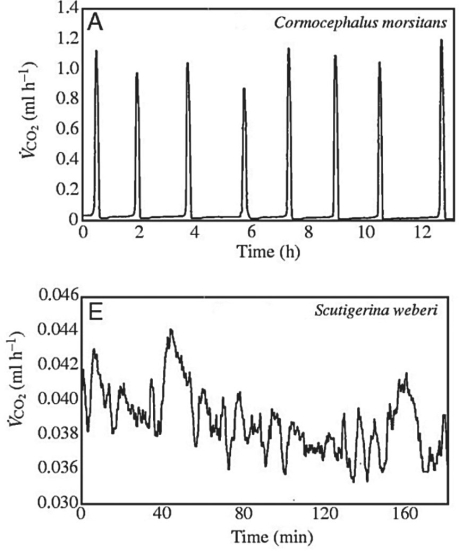Multiple Choice
Use the following information when answering the corresponding questions) .
Many terrestrial arthropods exchange gases with their environments by using tracheae, tubes that lead from openings called spiracles) in the animal's exoskeleton or cuticle directly to the animal's tissues. Some arthropods can control whether their spir opened or closed; opening the spiracles allows the carbon dioxide produced in the tissues to travel down the tracheae and be released outside the animal. Klok et al. measured the carbon dioxide emitted over time represented by VCO2) by several species of centipedes. Figure 31.2 presents graphs of their results for two species, Cormocephalus morsitans and Scutigerina weberi. C. J. Klok, R. D. Mercer, and S. L. Chown. 2002. Discontinuous gas- exchange in centipedes and its convergent evolution in tracheated arthropods.
 Figure 31.2
Figure 31.2
-Compare the graphs in Figure 31.2 of CO2 emission for Cormocephalus morsitans and Scutigerina weberi. What hypothesis can you make about each centipede's habitat?
A) C. morsitans lives in a habitat with more predators than S. weberi.
B) C. morsitans lives in a habitat that provides more carbon dioxide than S. weberi.
C) C. morsitans lives in a colder habitat than S. weberi.
D) C. morsitans lives in a dryer habitat than S. weberi.
Correct Answer:

Verified
Correct Answer:
Verified
Q28: How could you tell a millipede apart
Q29: The common ancestor of the protostomes had
Q30: What is not true of all arthropods?<br>A)
Q31: Which mollusc group can be described as
Q32: The body cavity type for arthropods and
Q33: Which adaptation is unique to insects among
Q35: On which body segment are arthropod wings
Q36: As stated in the text, "DNA sequence
Q37: A cephalopod's tentacles are modified from its<br>A)
Q38: You find what you believe is a